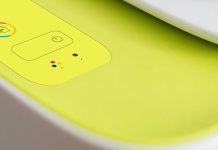This article has been just updated: January 17, 2024
For many people, vlogging is more than a pastime. Vlogging is now a legitimate form of entertainment and a popular source of income. In the early days of vlogging, quality hardly mattered.
Vloggers often recorded themselves with their smartphone video camera and published unedited footage straight to YouTube. Today, vloggers need high-quality video-recording equipment to stand out from the crowd and capture the fleeting attention of audiences worldwide—they need a good vlogging camera.
We’ve scoured the market and have come up with this list of the top 7 best vlogging cameras you can buy in 2024, making sure to include something for everyone.
If you take vlogging very seriously, you might even want to consider buying more than one vlogging camera so you can record from alternative angles professional filmmaking techniques to make a lasting impression and establish yourself as a vlogger who’s worth following.
1. Canon PowerShot G7 X Mark II
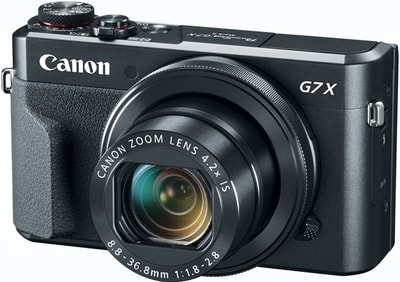
You would be hard-pressed to find a more versatile camera than the Canon PowerShot G7 X Mark II, especially for vlogging.
Features:
Its tilting touchscreen allows you to take shots from creative angles, and its DIGIC 7 image processor gives your photos and videos sharp details and accurate colors even at night or in other low-light situations.
While the Canon PowerShot G7 X Mark II doesn’t record 4K video, Full HD video recording is available at 60 frames per second, and you can even play it on a large-screen HDTV via the camera’s HDMI output.
Pros: Has a large, high-resolution, 3.0″ LCD monitor that tilts up 180° and down 45°. Records Full HD video at 60 frames per second. Benefits from the outstanding performance of the DIGIC 7 image processor.
Cons: No 4K video capture, but that shouldn’t be a problem as far as vlogging is concerned for at least a few more years.
2. Sony RX100 Mark V
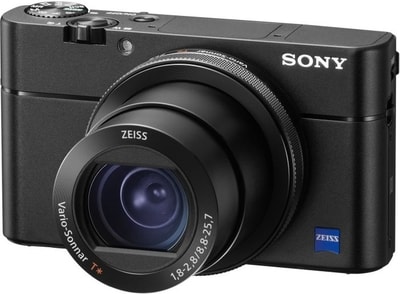
The Sony RX100 Mark V is a versatile compact with the performance of a mirrorless camera.
Features:
It boasts Sony’s advanced image processing system, which allows it to continuously shoot at up to 24 frames per second with a cutting-edge AF system that combines super-fast 0.05-second speed and wide, dense AF coverage employing 315 phase-detection AF points.
The camera can record 4K video footage oversampled from 5.5K, giving you more details than competing compact cameras.
If there’s one thing we don’t like about it, it would have to be the absence of touch controls, which would greatly improve its handling.
Pros: Continuous shooting at up to 24 frames per second. 315 phase-detection AF points. Records 4K video footage oversampled from 5.5K.
Cons: Lack of touch controls.
3. Canon EOS M6
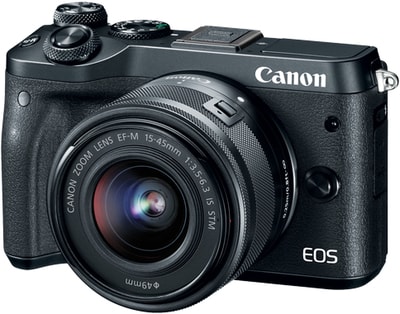 Despite receiving lukewarm review scores, the Canon EOS M6 is easily one of the best vlogging cameras with interchangeable lens.
Despite receiving lukewarm review scores, the Canon EOS M6 is easily one of the best vlogging cameras with interchangeable lens.
Features:
It has a 24.2 MP APS-C sensor that helps ensure clear, incredibly detailed, and vibrantly colorful pictures and videos. Data from the sensor are fed to the DIGIC 7 Image Processor, which provides high image quality and fast operation even in low light and when using high ISO settings. The camera’s large, high-resolution, 3.0″ tilt-type LCD helps you show your face to your viewers without awkwardly guessing if it’s in frame. The Canon EOS M6 is compatible with EF-M, EF- and EF-S lenses, giving you a wide range of options on how to capture yourself and the world around you.
Pros: Tilt-type LCD. Compatible with a wide range of lenses. Lightweight construction.
Cons: Doesn’t record 4K video footage. Questionable durability.
4. GoPro Hero7 Black
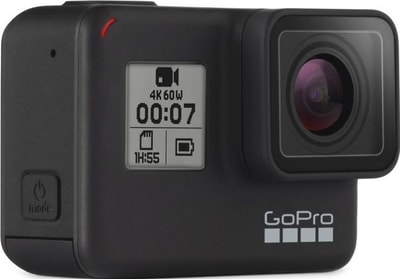 The GoPro Hero7 Black is the best action camera currently on the market.
The GoPro Hero7 Black is the best action camera currently on the market.
Features:
It records 4K video at 60 frames per second and Full HD video at up to 240 frames per second. With features like HyperSmooth and SuperPhoto, you can amaze your audience with outstanding video quality without spending money on expensive photo equipment and editing software.
The GoPro Hero7 Black has native support for live streaming with Facebook Live, so you can share every moment of your life with a press of a button.
Pros: Fantastic 4K video quality. Next-level software features. Unprecedented durability and water resistance.
Cons: The GoPro Hero7 Black has native support for live streaming with Facebook Live, so you can share every moment of your life with a press of a button.
5. Fujifilm X-A5
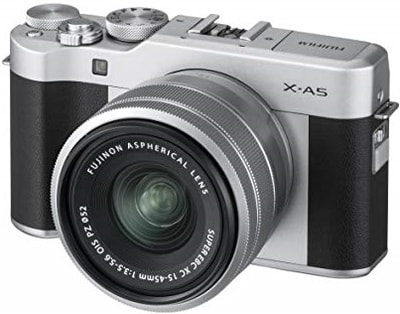 If you’ve so far been recording daily vlogs with your smartphone, it’s time to step up your game and purchase something like the Fujifilm X-A5, a low-end mirrorless camera with an affordable price and excellent picture quality.
If you’ve so far been recording daily vlogs with your smartphone, it’s time to step up your game and purchase something like the Fujifilm X-A5, a low-end mirrorless camera with an affordable price and excellent picture quality.
Features:
The X-A5 looks great, controls even better, and gives you the freedom to harness all of your imagination to create your own special shots with its premium image processor and tilting touchscreen.
The camera weighs only 361 grams, so you’ll hardly feel it in your bag or purse, but it supports Wi-Fi and Bluetooth connectivity and records Full HD video at up to 60fps for a 2x slow-motion effect.
Pros: Relatively affordable. Useful selfie mode to keep your Instagram feed fresh. Comes with a versatile kit 15–45 mm. lens.
Cons: Mediocre 4K video recording mode that’s limited to 15 frames per second.
6. Nikon D5600
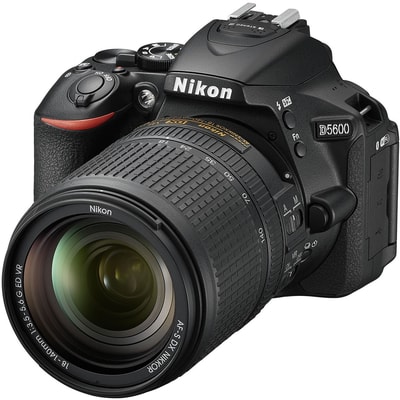 The Nikon D5600 is an affordable DSLR aimed at vloggers who want more than what entry-level DSLRs offer.
The Nikon D5600 is an affordable DSLR aimed at vloggers who want more than what entry-level DSLRs offer.
Features:
The camera has a 24.2 MP sensor that can record Full HD video at up to 60 frames per second. Unlike your smartphone, the Nikon D5600 won’t ask for a charge after just a few hours of taking pictures.
In fact, it can last up to 970 shots on a single charge, and there’s no reason not to carry a spare battery in your pocket. What you don’t need to carry is a data cable, because the Nikon D5600 can transfer pictures and video wirelessly over Bluetooth and Wi-Fi.
Pros: Wireless data transfer. Extraordinarily long battery life. Amazing video quality. Records Full HD video at up to 60 frames per second.
Cons: Doesn’t record 4K video.
7. Panasonic Lumix G85
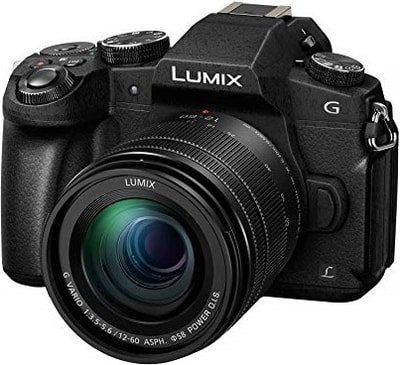 If you like the idea of being able to swap lenses based on your needs and enjoy the ergonomics of larger DLSR cameras—but not their price and weight—the Panasonic Lumix G85 might be the ideal vlogging camera for you.
If you like the idea of being able to swap lenses based on your needs and enjoy the ergonomics of larger DLSR cameras—but not their price and weight—the Panasonic Lumix G85 might be the ideal vlogging camera for you.
Features:
It records beautiful 4K video at either 24 or 25 frames per second, and you can see what the camera sees in real time through an HDMI port. The Lumix G85 has a microphone input that lets you connect an external microphone and make your vlogs sound great. While some of its controls feel overly complicated, the camera handles great, and we like its modest weight of just 453 grams.
Pros: Records beautiful 4K video. Allows you to connect an external microphone. Good compromise between point-and-shoot cameras and large DSLRs.
Cons: Some of its controls feel overly complicated
Conclusion
To record entertaining vlogs, you don’t need to spend thousands of dollars on expensive video equipment, but it wouldn’t be honest to say that equipment doesn’t matter when it comes to vlogging.
A good camera can set you apart from other vloggers out there and motivate you to press the record button every single day, which—as most successful vloggers would tell you—is what it takes to succeed.
FAQ
What features should one look for in a vlogging camera?
A good vlogging camera should offer high video resolution, preferably 4K for future-proof content. It should also have a flip screen for easy framing of shots, excellent autofocus to keep the vlogger sharp while moving, and good low-light performance. Built-in wi-fi or Bluetooth for easy sharing and a mic input for better audio quality are also essential features.
Why is autofocus important for vlogging?
Autofocus is critical for vlogging because it ensures the camera maintains sharp focus on the subject, even when the vlogger is moving around. Cameras with fast and reliable autofocus systems are preferred as they allow vloggers to concentrate on content creation rather than manual focusing.
Can I use an action camera for vlogging?
Yes, action cameras like the GoPro Hero series can be used for vlogging, especially for adventure and travel content. They are durable, waterproof, and compact, making them great for on-the-go shooting scenarios.
Do I need a camera with 4K capability for vlogging?
While 4K video capability isn’t strictly necessary, it’s highly recommended. 4K video offers higher resolution, which means better image quality and the option to crop or reframe the shot in post-production without significant loss of detail.
How important is image stabilization for vlogging?
Image stabilization is extremely important, as it reduces camera shake and produces smoother footage, which is preferred by viewers. Look for a camera that has either in-body stabilization (IBIS) or lens stabilization.
Should the vlogging camera be compact and lightweight?
For most vloggers, a compact and lightweight camera is ideal because it’s easier to carry around, which is particularly beneficial for those who vlog on the go. It also tends to be less intrusive, making it more comfortable for public vlogging.
What role does audio quality play in a vlogging camera?
Audio quality is just as important as video quality for vlogging. A camera that allows for an external microphone connection offers the ability to capture higher quality and more directional audio, which can significantly improve the end product.
What is the importance of a flip screen in a vlogging camera?
A flip screen, also known as an articulating screen, is crucial for vloggers because it allows them to see themselves while filming. This makes it easier to frame the shot and ensure they are always in focus and properly positioned in the frame.
Is a touchscreen interface beneficial on a vlogging camera?
Yes, a touchscreen interface can make adjustments faster and more intuitive, which is helpful when changing settings on the fly. It also simplifies tasks like setting the focus point or navigating through menus.
How does sensor size affect vlogging camera performance?
The sensor size influences the image quality, especially in low light conditions. Larger sensors typically perform better in such environments and offer a greater capacity for achieving a shallow depth of field, which is an aesthetic preference for many vloggers.
What connectivity options are essential for a vlogging camera?
Essential connectivity options include wi-fi or Bluetooth for wireless file transfer and remote control of the camera, as well as HDMI for connecting to external displays and USB for charging and direct data transfer.
Are interchangeable lenses necessary for a vlogging camera?
Although not necessary, having interchangeable lenses offers greater creative flexibility, allowing vloggers to adapt to different shooting environments and styles by changing their lenses.
What vlogging camera did most content creators prefer in 2024?
In 2024, many content creators preferred the Sony Alpha a6400 due to its excellent autofocus system, 4K video capability, and flip-up screen, making it versatile for various types of vlogs.
What is the advantage of having a built-in flash on a vlogging camera?
For general vlogging, a built-in flash is not critical, but it can be useful for photography or low-light situations where additional lighting is needed.
How does battery life affect a vlogging camera’s usability?
Long battery life is vital for vloggers, especially those who film content outdoors or travel frequently, as it reduces the need for frequent charging and allows for longer uninterrupted shooting sessions.
What was considered the best budget vlogging camera in 2024?
In 2024, the Canon EOS M50 was widely regarded as one of the best budget vlogging cameras, offering great video quality, dual pixel autofocus, and a flip screen at an affordable price.
Is weather sealing important for a vlogging camera?
Weather sealing can be very important depending on the vlogger’s activities. For those shooting travel, outdoor, or adventure content, a weather-sealed camera can provide extra protection against the elements.
What impact does low-light performance have on a vlogging camera?
Low-light performance is crucial for vloggers because it determines the camera’s ability to capture clear and noise-free footage in poorly lit environments, ensuring a quality viewing experience in any lighting condition.
Should I consider the brand ecosystem when choosing a vlogging camera?
Yes, considering the brand ecosystem is beneficial, especially for future proofing and access to a wide range of compatible lenses and accessories. Brands like Sony, Canon, and Panasonic have extensive ecosystems that cater to different levels of vlogging needs.
What was an excellent vlogging camera for travel in 2024?
The Sony RX100 series, particularly the RX100 VII, was an excellent compact camera for travel vlogging in 2024. It combines high-quality video, portability, and usability – ideal for capturing content while on the move.
For more information on the best vlogging camera models and up-to-date suggestions, you can visit reputable photography and technology review sites like DPReview or TechRadar. These platforms offer comprehensive reviews and camera comparisons, which can assist in making an informed decision tailored to your vlogging preferences and needs.




